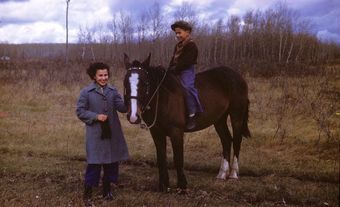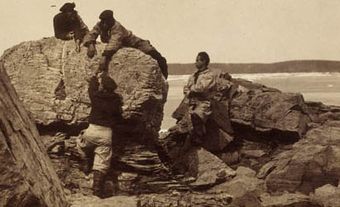Saskatoon, Saskatchewan, incorporated as a city in 1906, population 266,141 (2021 census), 247,201 (2016 census). The City of Saskatoon, the largest city in Saskatchewan, is situated in rolling parklands on the banks of the northward-flowing South Saskatchewan River, 352 km northwest of Regina. It serves as regional centre for the northern prairies and for central and northern Saskatchewan. It is noted for its extensive riverbank parks and trails, wide tree-lined streets and attractive University of Saskatchewan campus.
Settlement
The two Gowen sites show that hunting tribes were here 6,000 years ago. Stratified settlement sites at Tipperary Creek (now Wanuskewin) indicate regular winter habitation by Indigenous peoples. The region was first occupied primarily by Cree and Métis, augmented by refugee Dakota (Sioux) from the United States who settled at Moose Woods reserve south of Saskatoon in 1881.
In 1882 a survey party, headed by Commissioner John Lake, arrived to inspect land granted to the Temperance Colonization Society of Toronto and on the advice of Chief Whitecap of the Dakota (Sioux) chose the site of the future city, begun on the high east bank. Its name, Saskatoon, may be derived from the Cree word "Mis-Sask-quah-toomina," for the saskatoon berry, abundant locally. Settlers first arrived in 1883, but poor crops and the North-West Rebellion discouraged immediate growth.

Development
The routing through Saskatoon of a rail line from Regina to Prince Albert in 1890 caused growth of a new commercial centre on the flatter west bank. This new community appropriated the name Saskatoon, while the original settlement became Nutana. A third settlement, Riverdale (now Riversdale), arose south of the railway yards. All 3 incorporated as villages (1901-05) and in 1906 they combined to form the city of Saskatoon.
During the ensuing 7 years, Saskatoon became a hub of Western Canada's railway network, including all 3 intercontinental railways, with the rail town of Sutherland developing on its eastern fringes. Saskatoon underwent a boom, becoming a major distributive centre and, in 1909, gaining the provincial university. Inflated land values and overambitious land-subdivision schemes resulted. High interest rates and tight money brought a recession to Saskatoon as to all western cities, and was exacerbated by the Great War. A second boom in the second half of the 1920s was halted by the Great Depression, which hit Saskatoon the hardest of any English-Canadian city.
Only after World War II did significant development resume. During the 1950s, a healthy farm economy and population shift from the countryside made Saskatoon one of Canada's fastest-growing cities. Its boundaries were expanded significantly between 1955 and 1961. The opening of potash mines nearby (1958) and of uranium mines in northern Saskatchewan brought continuing growth during the 1960s and 1970s.
In the 1980s the market for uranium declined, but this was compensated for by the emergence of new high-tech industries. Increasing demand for potash and uranium, together with the initiation of gold and diamond mining and a vibrant agricultural biotechnology industry, have contributed to the progressive expansion of Saskatoon since the 1990s.
Cityscape
Located on glacial deposits within the meander belt of a large river, Saskatoon has an attractively variable topography, with oxbow lakes (Moon and Pike) nearby. The river is spanned by 7 bridges, both rail and road. They include the Traffic Bridge (1907) and the 42nd-Street Bridge (1983), which forms part of the city's Circle Drive. Prominent on the low west bank are the chateau-style Delta Bessborough Hotel, St John's Anglican and St Paul's Roman Catholic cathedrals and Knox United Church. Attractive residences and university buildings line the higher east bank.
The 3 villages that made up the original city are still recognizable. Nutana, the only colony townsite, is noted for its street of early residences, the earliest schools and the oldest business district (Broadway Avenue). The downtown core includes examples of "boomtime" and earlier buildings, notably the Land Titles Building, Canada Building, the CP Rail station and Third Avenue United Church. The Rumely Tractor Building dominates the warehouse district. The boomtime "castle" schools are important neighbourhood features as are the handsome houses of Nutana, Caswell Hill and City Park. Riversdale is noted for 2 Ukrainian Cathedrals, while Caswell Hill features some larger homes.
Noteworthy structures are the Saskatoon Centennial Auditorium (now TCU Place - Arts and Convention Centre; 1968), Sturdy Stone Building (1979), Saskatchewan Place (now Credit Union Centre; 1988) and City Hospital (1993).
Though ambitious plans for city development were proposed early (1911, 1913), it was not until 1929 that a zoning plan was established. Land acquired by the city through forfeiture of holdings during 2 depressions was augmented when, in 1957, a"land bank"was developed through progressive purchase of available properties. Removal of the railyards, and their distinctive pedestrian overpass, from the city centre (1964-65) allowed for downtown retail mall development.
During the mid-1970s citizen action brought establishment of the Meewasin Valley Authority (1979) to conserve the riverbank. Currently being developed is the River Landing project on the south downtown river edge. Its first phase includes a riverside park, riverfront, a live performance theatre and an urban centre of mixed uses. The northeast sector is currently the focus of residential expansion and there is market pressure on the surrounding Regional Municipality of Corman Park to increase the number of country acreages.
Population
Initially, settlement was from eastern Canada, the United Kingdom and the United States, but later immigrants came from most parts of Europe, notably Ukraine and the Austro-Hungarian Empire. Persecuted religious groups - Mennonites, Hutterites, Doukhobors - who found a home in Saskatchewan have had an impact on Saskatoon's cultural identity. From 1946 to 1960, the city saw continued immigration, including war brides.
This was complemented by a dramatic population shift from the countryside and by municipal boundary expansion, notably the incorporation of the town of Sutherland (1956). The ensuing decades saw significant immigration from India, Pakistan and China and subsequently from the Philippines, Vietnam and Latin America. The shift from country to town has continued and there has been a rapid growth in the Indigenous population.
According to the 2021 census, people citing German ethnic origins make up the largest ethnic group, at 22.7 per cent of the city’s population, followed by English (18.4 per cent) and Scottish (15.5 per cent). Visible minorities account for 24.7 per cent of city residents, with South Asian, Filipino and Chinese people comprising the largest communities within this group. Saskatoon is also home to a large number of Indigenous people, at 11.5 per cent of the total population.
Economy and Labour Force
Because of its dependence on agriculture, Saskatoon has experienced many "booms and busts." Its earliest "boom" came in 1903 with the arrival of the Barr Colonists. This was followed by the real estate "boom"of 1911-12. Other cycles followed; however, continued diversification, beginning with the expansion of the mining industry in 1970s, had diminished this tendency until the "boom" of 2007. House prices had risen by more than 50% and condominium conversions were occurring at an historic rate. The price increases were mainly attributed to returning former residents, increased in-migration and a booming economy.
Recent trends include a significant increase in advanced-technology industries and manufacturing to service the resource and agricultural sectors. Saskatoon continues to act as a retail and distribution centre, as well as a centre for health and education services, business and mining services, food processing and research. The research capabilities of the university and the presence of Innovation Place Research Park have had a significant impact on Saskatoon's economy, especially in information technology and the growing agricultural biotechnology industries. First Nations people are playing an ever-increasing role in the economy.
Transportation
Saskatoon is located on the Trans-Canada Yellowhead Highway. Five traffic bridges cross the South Saskatchewan River and an almost completed ring-road runs through the city. Public transport began with the operation of a ferry from 1884 to 1907, when the first traffic bridge was built. In 1913 streetcars were introduced, to be replaced gradually by trolley buses and then by buses. Although no longer a hub of rail lines as in the early 1900s, Saskatoon is still served commercially by the CN transcontinental main line and a secondary main line of CP Rail. VIA Rail maintains a minimal transcontinental passenger service.
During World War II Saskatoon was home to one of the schools of the Commonwealth Air Training Plan. In 1919 Keng Wah Aviation trained young Nationalist Chinese pilots here. The John G. Diefenbaker International Airport handles national and US flights. Provincial bus service is provided by Saskatchewan Transportation Company and long-distance service by Greyhound Bus Lines. Saskatoon's central location enables its region to support more than 100 freight transport companies.
Communications
Saskatoon has 10 radio stations, including a community radio station, and 3 TV stations. SaskTel, the province's telephone company, is still the prime provider of telecommunications services even though outside companies are beginning to make inroads. There are two newspapers - a daily (Star-Phoenix), a weekly agricultural paper (Western Producer) and an independent magazine, Planet S. Saskatchewan Business Magazine, Grain, a literary magazine, and the annual Saskatoon History Review are all published in Saskatoon. Publishers include the literary Thistledown Press; Purich Publishing specializing in Indigenous issues, law, education and Western history; and the University of Saskatoon. SaskTel provides internet access to the public, as well as to other Internet service providers, and a local freenet run by volunteers has been established.
Government and Politics
The city charter (1906) specified a commission government, the city's officers being the mayor and at least one appointed commissioner. The strong rule of Commissioner C.J. Yorath (1913-21) gave permanency to this system, much criticized initially. In early aldermanic elections, men voted in each ward where they owned property. In 1920 female suffrage was introduced but, at the same time, the ward system was abolished. It was reintroduced by the province in 1973, abolished in 1988, to be introduced yet again in 1991 after citizen protest.
At present, city council consists of the mayor and 10 councillors, one for each ward, elected for a term of 3 years. The city has 2 standing committees and several advisory committees, boards and commissions with citizen representation. Relations between the municipal and provincial governments are defined by the Urban Municipality Act (1984) and to a lesser extent by the Planning and Development Act (1983). Meewasin Valley Authority oversees development along the river corridor.
Cultural Life
The University of Saskatchewan and its associated religious colleges and SIAST-Kelsey Institute, the First Nations University of Canada (Saskatoon campus) and the Saskatoon Public Library are the city's key educational institutions.
A sympathetic cultural climate has fostered a strong writing community. Novelists Farley Mowat, Max Braithwaite, Edward McCourt and poet Anne Szumigalski have called Saskatoon home. Today's Saskatoon authors include award-winning poet Elizabeth Brewster, Governor General's Literary award-winning novelist Guy Vanderhaeghe and biographer Bob (Robert) Calder, and historian Bill Waiser.
A lively performing arts scene includes 3 professional theatre companies, Persephone, 25th Street Theatre and Shakespeare on the Saskatchewan, as well as the French La Troupe de Jour, an amateur company, Saskatoon Gateway Players and the Fringe Festival.
The city has its own symphony orchestra and there are opera companies, choirs, folk music groups, bands and a jazz society, which stages the annual Saskatchewan Jazz Festival. Folk singer Joni Mitchell and jazz pianist John Ballantyne grew up here. Lyell Gustin, well-known Canadian music educator, made his home here. Ethnic organizations operate through the Saskatchewan Intercultural Association and showcase their performing arts at "Folkfest." Saskatoon is well known for its Ukrainian folk-ballet ensemble. The Centennial Auditorium is the city's main theatre for the performing arts and the Broadway Theatre provides one of the few remaining venues for repertory cinema in Canada.
The riverbank Mendel Art Gallery, the university's Kenderdine Gallery, Nutana Collegiate's collection of early Canadian art, the avant-garde A.K.A. Gallery, the Photographers' Gallery and the Saskatchewan Craft Gallery are the city's major public art galleries. The university's art department has had a strong artistic influence, especially through the Emma Lake Artists' Workshops. Ernest Linder, William Perehudoff and Dorothy Knowles are internationally known artists, as is Eli Bornstein, editor of The Structurist magazine.
The Western Development Museum (known for its pioneer street and its excellent collection of agricultural machinery and antique cars), Diefenbaker Canada Centre, the Ukrainian Museum of Canada, the Remai Modern and the Meewasin Valley Centre are the city's major museums. The university has several museums, the most spectacular being the Geology/Biology Museum with replicas of dinosaurs. Historic sites include Marr Residence (1884), used as a field hospital during the North-West Rebellion; Trounce House (1883), Saskatoon's oldest house; Pioneer (Nutana) Cemetery; Stone School House (1887); Rugby Chapel (1911); and John G. Diefenbaker's riverbank grave. There have been 2 recent historic restorations, the atmospheric Roxy Theatre (1930) and the College Building (1912) at the university, which is both a provincial and national historic site.
The attractive Forestry Farm Park and Zoo is located on what was the site of one of 2 Dominion Forest Nursery Stations (1913). Wanuskewin Heritage Park, an internationally significant heritage site, interprets the Indigenous people of the plains' history and culture. The annual Saskatoon Prairieland Exhibition celebrated its 110th anniversary in 1996.
Junior hockey, the Blades, and football, the Hilltops (Canadian champions 13 times, most recently in 2007), and university hockey and football, the Huskies, are among the best-known current teams. Additionally, there is the Saskatoon Rush lacrosse team, the Rattlers basketball team and the Saskatoon Berries baseball team. Saskatoon had professional hockey in the 1920s and 1950s, and a number of nationally known fastball teams. Some favourite Saskatoon sports celebrities are Ethel Catherwood, high jump medalist in the 1928 Olympics, hockey player Gordie Howe, pentathlete Diane Jones Konihowski and speed skater Catriona Le May Doan. Saskatoon has played host to many national sports events and in 1990 hosted the World Junior Hockey Championships. Sports facilities include Gordie Howe Park, Harry Bailey Aquatic Centre (1976), Saskatoon Field House (1978-79), the boat house (1987) and Saskatchewan Place (1988).
Riverbank trails and parks are a major additional attraction, especially Saskatoon's weir with its summer population of pelicans. Outside the city, Beaver Creek Conservation Area and Cranberry Flats provide nature education, while the nearby provincial parks of Pike Lake and Blackstrap with its artificial "mountain" offer traditional camping and water recreation opportunities.

 Share on Facebook
Share on Facebook Share on X
Share on X Share by Email
Share by Email Share on Google Classroom
Share on Google Classroom



